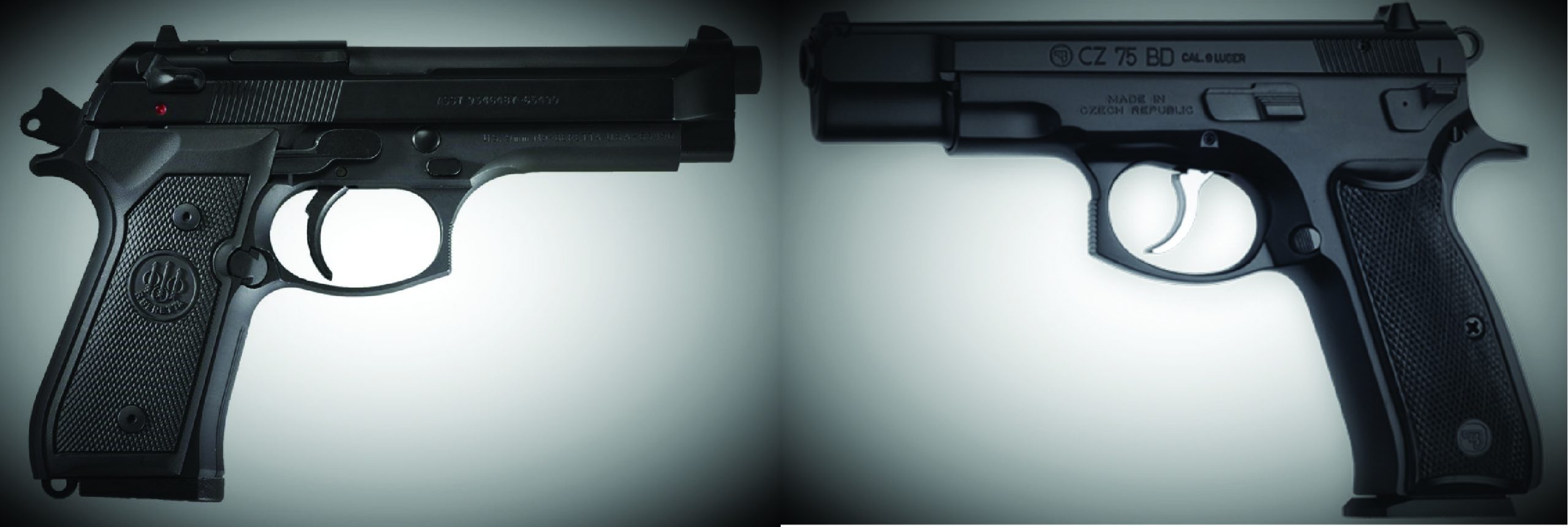
One drawback of carrying the Beretta M9 and the CZ 75 BD is the size and the weight. You begin questioning your wisdom of carrying either. Are these war horses still relevant today? I guess that depends on your perspective.
If “show me” is your mantra, you may be from Missouri. Although I am not from Missouri, I would still need convincing, and you would have to show me why, or why not, a CZ 75 BD or a Beretta 92FS/M9 might be a defensive pistol carry answer. And of course, you may not consider either; whereas, you can stop reading now. If you are interested in one (or both) of these pistols, then enjoy the read.
First, let us look at some specifications for both pistols:
| Product Name | CZ 75 BD – 9mm | Beretta M9 – 9mm |
| Firearm Type | Handgun | Handgun |
| MSRP | $631.00 | $675.00 |
| Chambering | 9mm Luger | 9mm Luger |
| Magazine Capacity | 16+1 | 15+1 |
| Magazine Type | Double Stack | Double Stack |
| Frame | Steel | Steel |
| Grips | Plastic | Plastic |
| Trigger | Mech DA/SA | Mech DA/SA |
| Trigger Pull Weight (measured) | ||
| Double Action: | 11 lbs. 14.6 oz. (5-pull average) | 11 lbs. 10.6 oz. (5-pull average) |
| Single Action: | 6 lbs. 11.2 oz. (5-pull average) | 6 lbs. 12.6 oz. (5-pull average) |
| Sights | Fixed Three-Dot (luminescent) | Fixed Three-Dot |
| Sight Radius | 6.9375 in. | 6.1 in. |
| Barrel | Cold Hammer Forged | Cold Hammer Forged |
| Barrel Length | 4.6 in | 4.9 in |
| Weight | ||
| Unloaded: | 2 lbs. 3.5 oz. (with magazine) | 2 lbs. 0.7 oz. (with magazine) |
| Loaded: | 2 lbs. 11.5 oz. (with 16+1 147-grain JHP) | 2 lbs. 8.4 oz. (with 15+1 147-grain JHP) |
| Overall Length | 8.1 in. | 8.5 in. |
| Height | 5.4 in. | 5.4 in. |
| Width | 1.4 in. | 1.5 in. |
| Safety | De-cocking Lever, Safety Stop on Hammer, Firing Pin Block Safety | De-cocking Lever, Safety Stop on Hammer, Firing Pin Block Safety |
If you are observant, you may notice something about the above specifications. There is not that much difference between the CZ 75 BD and the Beretta 92FS/M9. The true evaluation is in the hand and how they perform. A final choice may simply come down to personal preference for one over the other.
Of the two, the Beretta 92FS/M9 is the most well-known pistol, as it has been used by entertainment types for our viewing enjoyment in action movies and in television, and it has been with our U.S. military since 1984, and that has sold a lot of Beretta pistols to the shooting public. The CZ 75 BD is, simply put, just not as sexy-looking as the Beretta. That may be a singular and strong non-selling point to some. I know that I am looking forward to having an INOX version of the Beretta 92FS and a 92X Compact someday. On the same token, I know that a stainless-steel version of the CZ 75B exists and I would love to have one in the collection. However, I would consider the CZ 75 as the being the Ford GT to the Beretta’s Ferrari, and I find it ironic that the Beretta is also an Italian product.
Ergonomics
Let us talk ergonomics a bit, setting aside the styling differences.
Feel
The CZ 75 BD and the Beretta M9 feel great in the hand, although they are wide-body pistols. Although the grip of both pistols fit the hand, the grip may be too large for some, but thinner grip panels are available.
The grip panels of the Beretta 92FS/M9 are slightly rounded on the sides, unlike that of the CZ 75 BD; whereas, the grip panels are not only rounded but sculptured with swells that fit a wide variety of hands.
I had replaced the plastic grip panels of the Beretta for standard wood grip panels that while they do not have the gripping surface of the plastic panels, they are adequate for my use, and they are of my preferred wood construction. The plastic grip panels of the CZ 75 BD were also exchanged with genuinely nice grip panels from The Altamont Company, a maker of grips for many handgun manufacturers. These grips also have the swells as with the original grips panels but are made of highly-polished laminate material with adequate checkering where it is needed.
My ability to point both pistols is excellent, as they just blend into the hand and become an extension of it. Neither of these pistols feel like they do not belong in my hand, and I do have a few pistols that do feel foreign to a normal grip.
Both pistols feel well-balanced in the hand. The balance between grip and barrel is particularly good, with the pistols feeling neither barrel nor butt heavy. Even when fully loaded, the balance does not change.
Some may say that the pistols are heavy, loaded or not. Since the CZ 75 BD weighs 2.719 lbs. (with 16+1 147-grain JHP) and the Beretta 92FS/M9 weighs 2.525 lbs. (with 15+1 147-grain JHP), and as compared to Glock G17 weighing in at 2.0175 pounds (loaded), there may be something to that, but we are talking about an approximate ½-ounce difference in weight between the three pistols with a one or two round advantage going to the Glock G17.
Controls
The location of de-cocking controls is similar in operation; albeit, different in location. The safety/de-cocker of the berretta is on the slide; whereas, the de-cocker of the CZ 75 BD is on the frame.
With the Beretta 92FS/M9, press the safety/de-cocking lever down until the safety/de-cocking lever clicks and the hammer falls forward. The Beretta is now in double action mode and the safety is now in the ‘safe’ position.
Once the pistol is de-cocked and in the safe position, a light forward push on the de-cocking lever returns the de-cocker to the fire position (the default position); else, if no forward pressure on the de-cocking lever is made, the pistol remains in ‘safe’ mode; whereas, the trigger is disconnected. The de-cocking lever on the CZ 75 BD works differently, although the principle of de-cocking the hammer remains.
To de-cock the CZ 75 BD, press down and forward on the rear of the de-cocking lever. At some point, you will hear the de-cocking lever click, the hammer falls to a quarter-cocked position, and the pistol is now in double-action mode. Release the destocking lever to allow its return to the rest (fire) position. Unlike the Beretta, the CZ 75 BD is a de-cocker-only pistol.
The polymer guide rod of the Beretta 92FS/M9 is exposed when the slide is retracted; whereas, the guide rod of the CZ 75 BD is hidden. Recoil assemblies (recoil spring and guide rod), in both pistols are not captive. Both recoil systems are effective. A stainless-steel guide rod is available for the Beretta 92FS/M9, but not for the CZ 75 in any variant.
The CZ 75 BD has a Slide Stop that locks the slide back on the last round fired. The Slide Stop also serves to disassemble and assemble the pistol; whereas, the Beretta 92FS/M9 has a Slide Catch that locks the slide back on the last round fired. In addition, a Disassembly Device allows for extremely quick and simple field stripping of the pistol and prevents casual or involuntary disassembly.
Disassembly for Maintenance
Disassembling for maintenance/inspection of both pistols is extremely different, with the CZ 75 BD being the more complex of the two. With the Beretta 92FS/M9, a button is pushed on the right side of the frame after the slide is locked back and then a lever on the left side of the frame is pressed down to release the slide. Release the ‘Slide Catch’ while holding onto the slide to remove the slide from the frame.
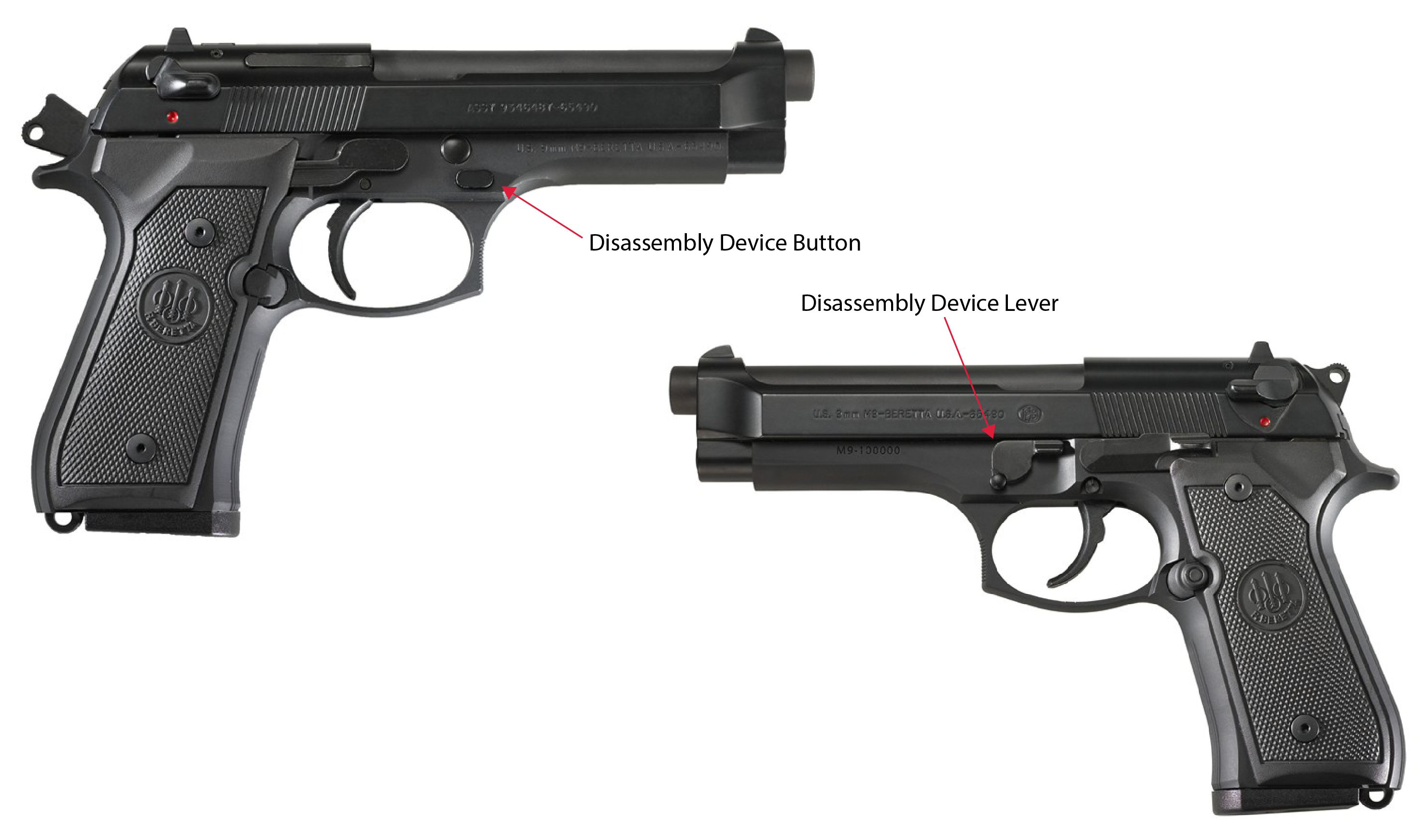
Beretta 92FS/M9 Disassembly
I have also included a pictorial view of the Beretta disassembly from the Beretta manual, as shown below.

The CZ 75 BD requires that matching marks on the slide and frame be aligned, then the Slide Stop pin that protrudes on the right side of the frame is pushed out (when new, substitute “pushed” with “tapped”), which allows the Slide Stop to be removed from the left side of the frame, thus allowing the slide to be removed. Although the manual states that the base of the magazine can be used to remove the Slide Stop, I would not recommend it if you value the finish of the pistol. I use a wooden dowel to force the Slide Stop from the detent that holds it in place. This prevent any scratching of the pistol’s surface. A small plastic-headed mallet or polymer punch would also work to tap or push the Slide Stop from its detent. Just do not use the (metal) magazine base unless you have replaced metal magazine base plates with Rubber Magazine Bumpers from Cajon Gun Works.

CZ 75 BD Disassembly
Sights

Beretta M9 Sights
The Beretta M9 sights are different from what someone not associated with the military would be used to sighting through. The front sight is the conventional dot sight while the rear sight has a partial dot. Line up the front dot to complete the rear dot and you have the complete sight picture.
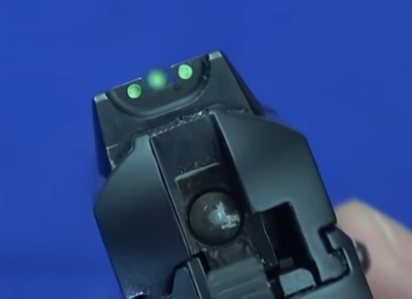
CZ 75 Photo-Luminescent Sights
The CZ 75 BD sight system is a conventional three-dot system with a slight twist. The front and rear dots are luminescent; that is, subject them to bright light and they will glow for an abbreviated time. I conducted a short experiment at the range. I shined a flashlight onto the sights, turned the lane light off, ran several Mozambique drills, and could still see the sights glowing after the session was completed. Are they as effective as night sights? No, but they can be used in low-light situations, at least for a while. The sights are smaller than that found on the Beretta but are adequate for my old eyes.
The sights on both pistols are good but can be made better with night sights of your choice.
Range Doody (sic)
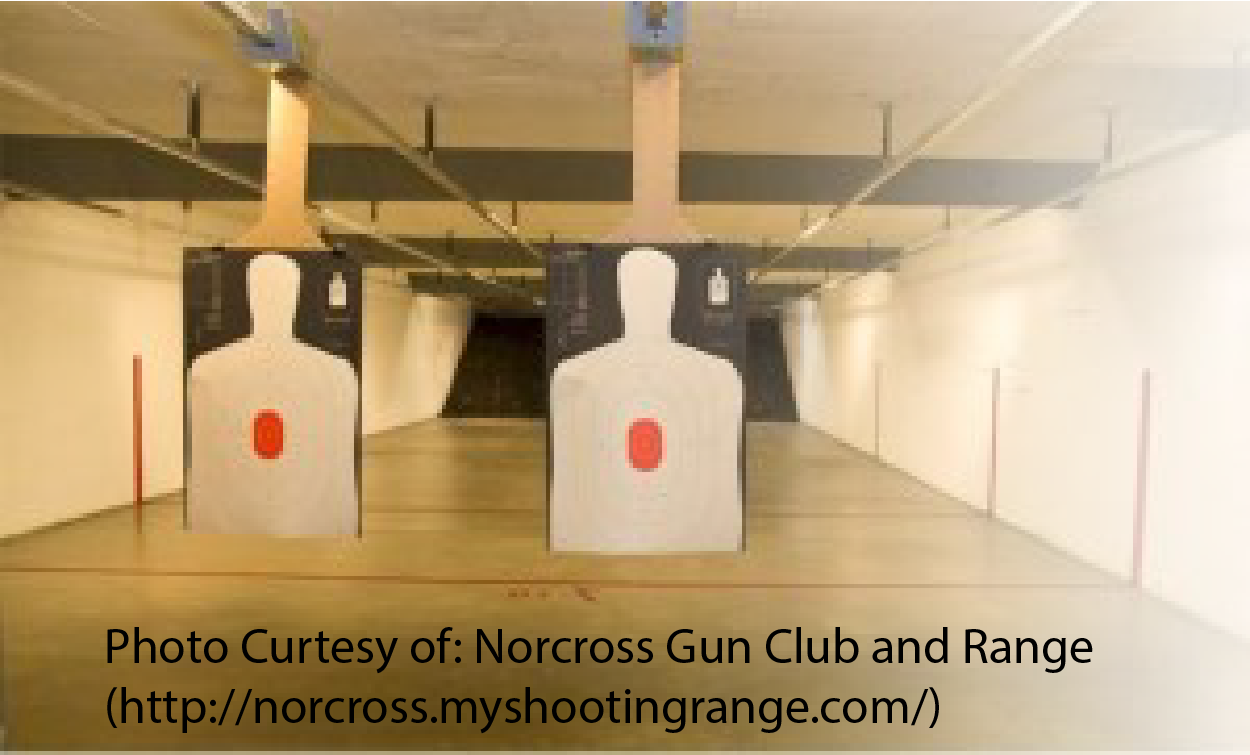
It matters not what we compare between the CZ 75 BD and the Beretta 92FS/M9, because the proof is in the pudding and the pudding is called range time.
The objective here is to shoot the same ammunition through both pistols and measure the results in terms of accuracy, reliability, and handling.
For the range session, I was using Mag-Tech 124-grain FMJ. I am not going to expend defensive ammunition, as this has been done and both pistols proved their worth in that department.
Accuracy
Both pistols are highly accurate, and I can only take their accuracy so far, given my human limitations. More trigger time with one or the other might improve my accuracy with them, but for now any accuracy reflects my shooting them and not that of the pistols. At a combat distance of 21-feet, both can take out the “X” even on one of my bad days. At 25-yards, I give a bit to the CZ 75 BD in single-action mode, but if I shoot them on another day, the Beretta M9 might just win out. They are that close in the accuracy department.
Running “Mozambique” drills with both at 21-feet shows me that they are equal in accuracy, although I do prefer the trigger of the CZ 75 BD over that of the Beretta M9 for that first double-action shot.
Handling
The CZ 75 BD and the Beretta 92FS/M9 both handle wonderfully. While heavy, they both can be brought to bear on the target without working out with weights prior to shooting them to get accustomed to the weight. The weight of the pistols reminds you that you are, indeed, shooting an all steel pistol. In fact, I would say that if you swapped either one of these pistols with a polymer pistol, such as a Glock pistol, you might find yourself ‘over-traveling’ the Glock, at first, when you bring it to bear on the target. However, as I mentioned, the weight of these two pistols is only an approximate ½-ounce difference in weight with a fully-loaded Glock G17, and unless you are perfectly tuned into Glock pistols, the weight is not going to matter.
Concealment
I am not going to go into much in the way of concealing the Beretta 92FS/M9 or the CZ 75 BD that has not been gone into the articles that have already been produced for these two pistols.
At 2 lbs. 11.5 oz. (with 16+1 147-grain JHP) for the CZ 75 BD and 2 lbs. 8.4 oz. (with 15+1 147-grain JHP) for the Beretta 92FS/M9, neither would be considered a lightweight carry. The user of both pistols must make a solid commitment to carrying and concealing these pistols, if that is the game plan. If you are used to carrying and concealing a full-size 1911 (2 pounds 12.2 ounce (with 7+1 of 230-grain JHP), as I am, the weight is not an issue. Bulk; however, can be.
One of my favorite holsters, and one that works with both the CZ 75 BD and the Berretta 92FS/M9, and a few others, is the “Cumberland” from Simply Rugged Holsters.

Beretta M9 in a “Cumberland” from Simply Rugged Holsters
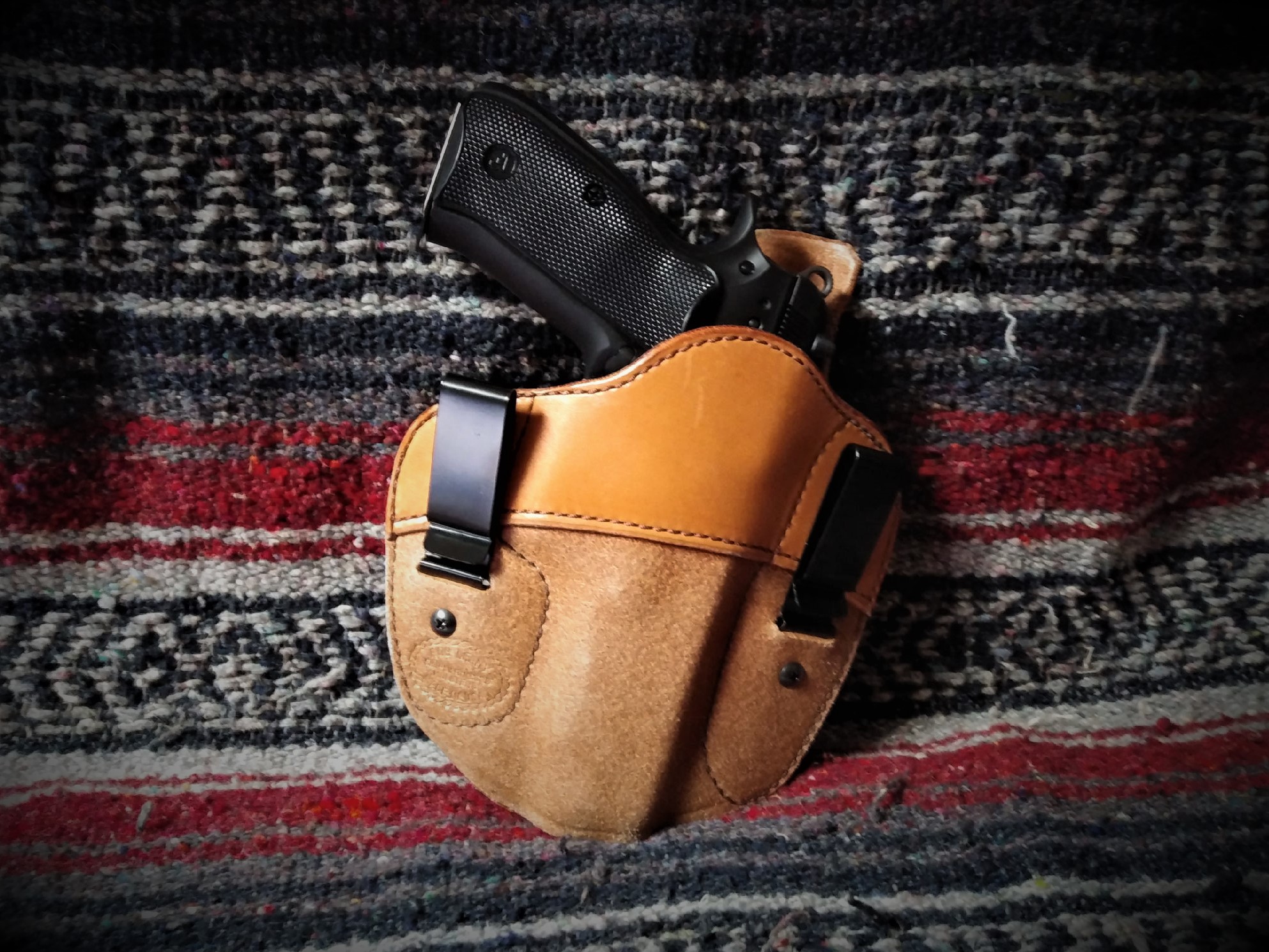
CZ 75 BD in a “Cumberland” from Simply Rugged Holsters
A shoulder holster system worthy of a look is from Craft Holsters, shown below. A less expensive option than the Galco Shoulder Holster System, but is of the highest quality. Falco’s Customer service is excellent.
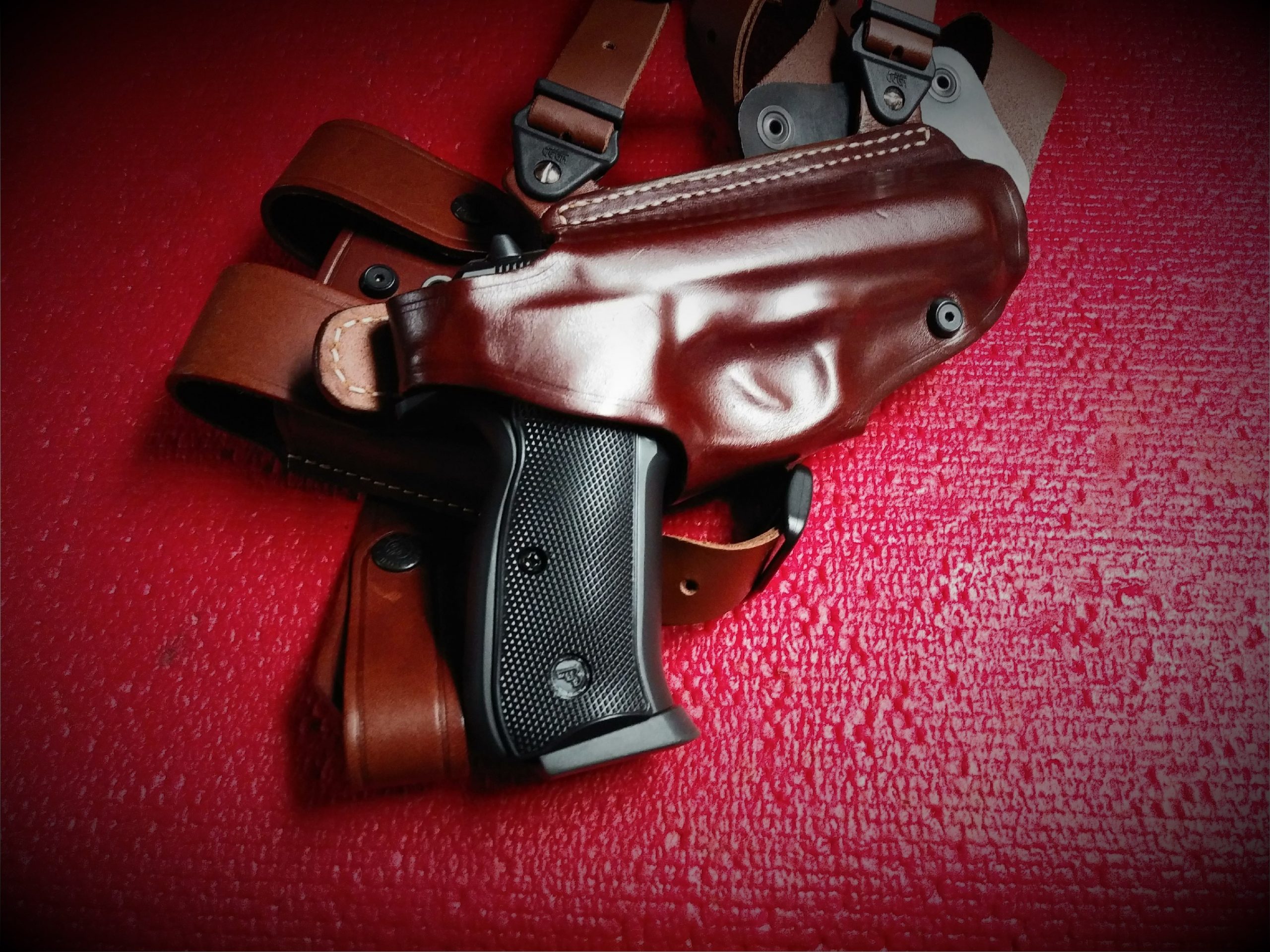
CZ 75 BD in a Shoulder Holster System by Craft Holsters (also available for Beretta 92FS/M9)
Summary
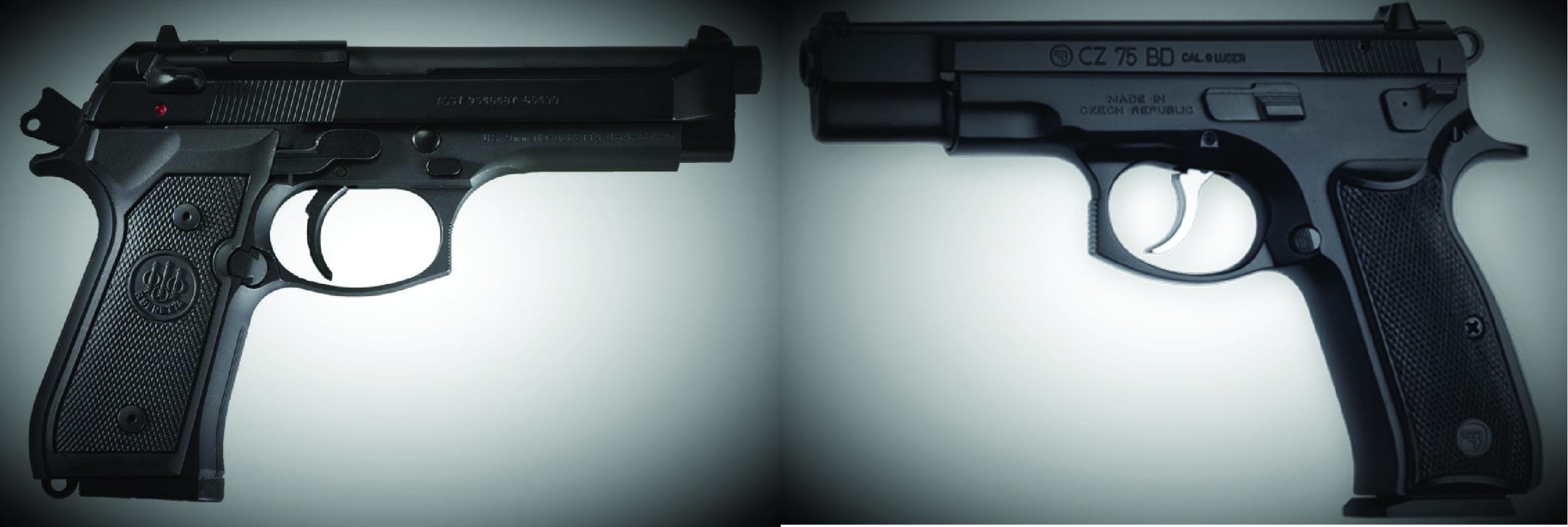
Both pistols are more than capable of serving as your daily bodyguard. These are full-size service pistols, and as such, considerations must be made as to the best method to carry, if these are to be carried at all. Since I have carried a full-size, all-steel 1911 for years, the weight or size is not a factor in my decision to carry either one of these pistols. Since they are chambered for the 9mm Luger cartridge, I cannot produce an excuse not to carry a spare magazine or two of 9mm ammunition in a separate pouch or man-vest pocket.
I think it ludicrous to say that the Beretta 92FS/M9 and the CZ 75 is “old school” technology. They are, to put it simply, a different breed of handgun that are as relevant today as they were in their heyday. In fact, for some, the heyday has not passed.
The bottom line is that if you genuinely enjoy firearms, you need one or both pistols, or a variant thereof, in your collection.
References
Beretta 92 vs CZ 75: https://www.youtube.com/watch?v=-Bz4bxs6x5Y
Beretta M9 vs. CZ75 Part-2: https://www.youtube.com/watch?v=WaTXznXH2dw
Beretta 92 vs CZ 75 vs Sig Sauer P226: https://www.youtube.com/watch?v=Du89uxFTvt0
![]()

